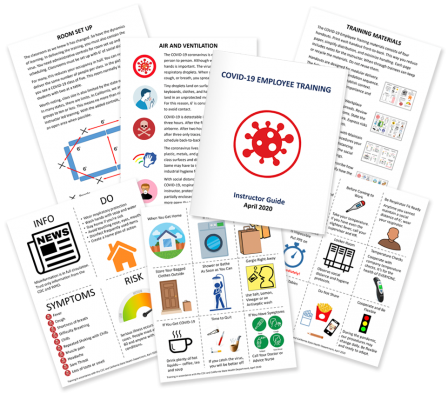Place COVID-19 employee training signage where behaviors must change.
Social distancing is not easy and even harder at work. Subsequently, it is unnatural and employees need reminders. For social distancing and face masks in the workplace, you need reinforcement. To stop the spread of COVID-19, you need signage. You not only need signage; you need strategically placed signs. Above all, signs are an easy effective means to trigger behaviors. In other words, knowing how signs influence behaviors helps with COVID-19 containment.
COVID-19 EMPLOYEE TRAINING SIGNAGE PURPOSE
Mostly, signs give direction and warn about potential dangers. They tell you to perform specific behaviors, like hand washing and disinfection. For this reason, they reinforce your COVID-19 employee training. Signs are relatively inexpensive and do not require special equipment. Effective signs prompt behaviors across language and cultural differences.
With minimal investment, signage plays an important role in triggering behaviors. Research shows signs effectively change behaviors in a variety of ways. They relate driving instruction, schedules, recycling, and other causes. At work, signs communicate proper ergonomics, use of PPE, and safety.
CHARACTERISTICS OF EFFECTIVE SIGNS
Research by Julia Meis and Yoshihisa Kashima reveal what makes signs effective. Signs are more effective when displayed in close proximity to an action. They must specifically state a desired behavior that is relatively convenient. In other words, signs prompt you to do something you already know. When properly placed, signs trigger behaviors at an opportune time.
For this reason, signs are key reinforcers to COVID-19 employee training. They relate specifically to an action to be performed. Signs must clearly specify what to do. They must be as close to the point of action as possible. For instance research indicates effective signs link a goal to an action. Research also shows close to the action matters too.
COVID-19 EMPLOYEE TRAINING SIGNAGE EXAMPLES
As an example, place hand washing instructions directly above the sink. To trigger an action, a sign must clearly state the goal. Like, “Prevent the spread of COVID-19 and Wash your hands!†Research also suggests graphical representation of behaviors increase the likelihood of compliance. In other words, signage can compliment behavioral changes your COVID-19 employee training introduces.
With washing hands, where to place signs is clear and evident. With social distancing, sign placement must be more fluid. To prompt people to social distance, you need more placement. Anywhere people gather, you need signs. This includes mail, copy, and conference rooms. You also need signs in shops, cafeterias, cubes, offices and restrooms.
SIGNAGE AND SYMBOLS
According to Meis and Kashima, effective signs leverage symbols and prompts. Rather than rely on language and words, signs leverate symbols and images. To work, symbols require you to know the meaning of icon and images. To trigger behaviors, signs often rely on commands and declarative language. For prompts to work, you must know the language. To communicate to a diverse group of employees, use unambiguous language.
In summary, signs which combine symbols and prompts are generally the best. They use both linguistic information and graphical features to emote a message. To work, sign placement must be near areas where controls are needed. A sign’s purpose and clarity are essential to its effectiveness. Signs communicate what to do in straightforward images and language. For successful COVID-19 employee training, well-placed signs make a difference.
Prepare your organization with COVID-19 Employee Training materials and Instructor Guide. Then, reinforce new behaviors with FREE signage! Leverage single-use training materials. Prevention, hygiene, hand washing and PPE. It’s all included and complete! Print and you’re— Ready to go!


